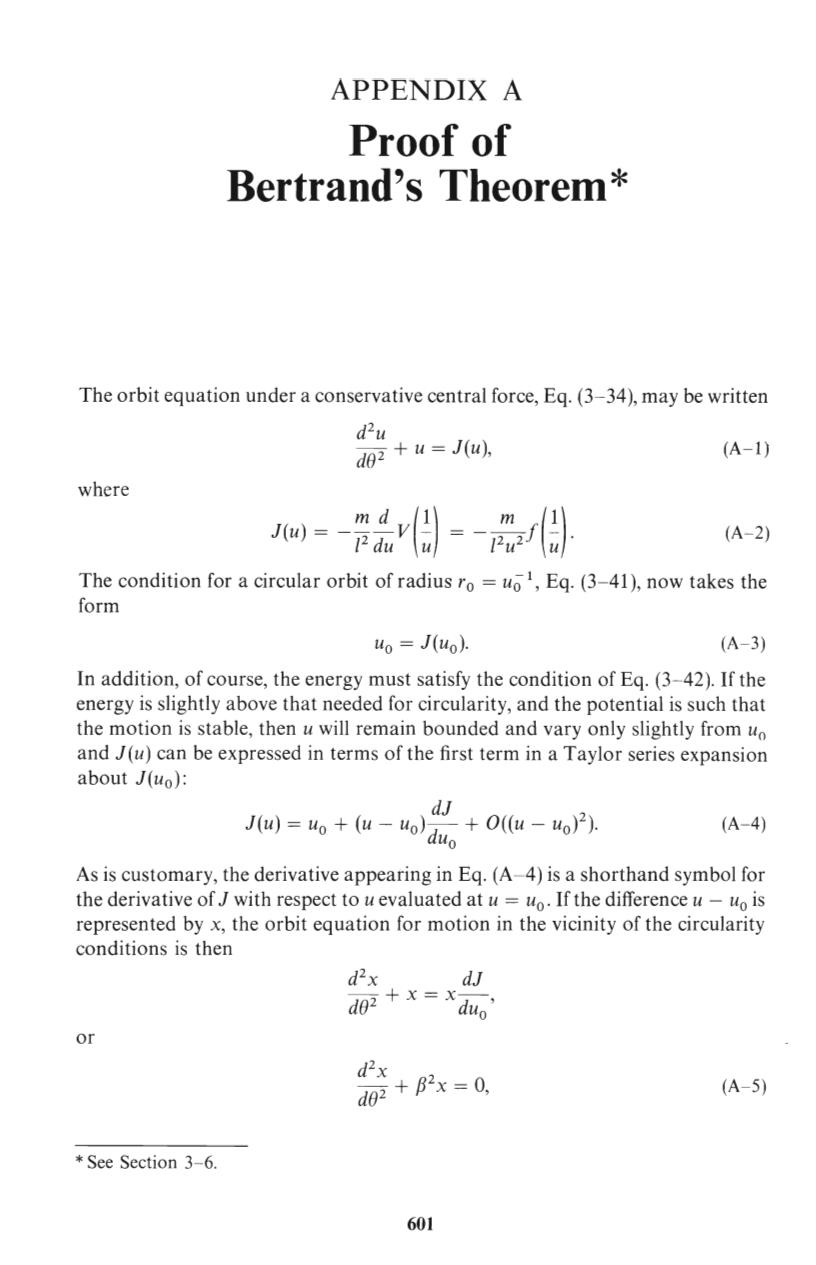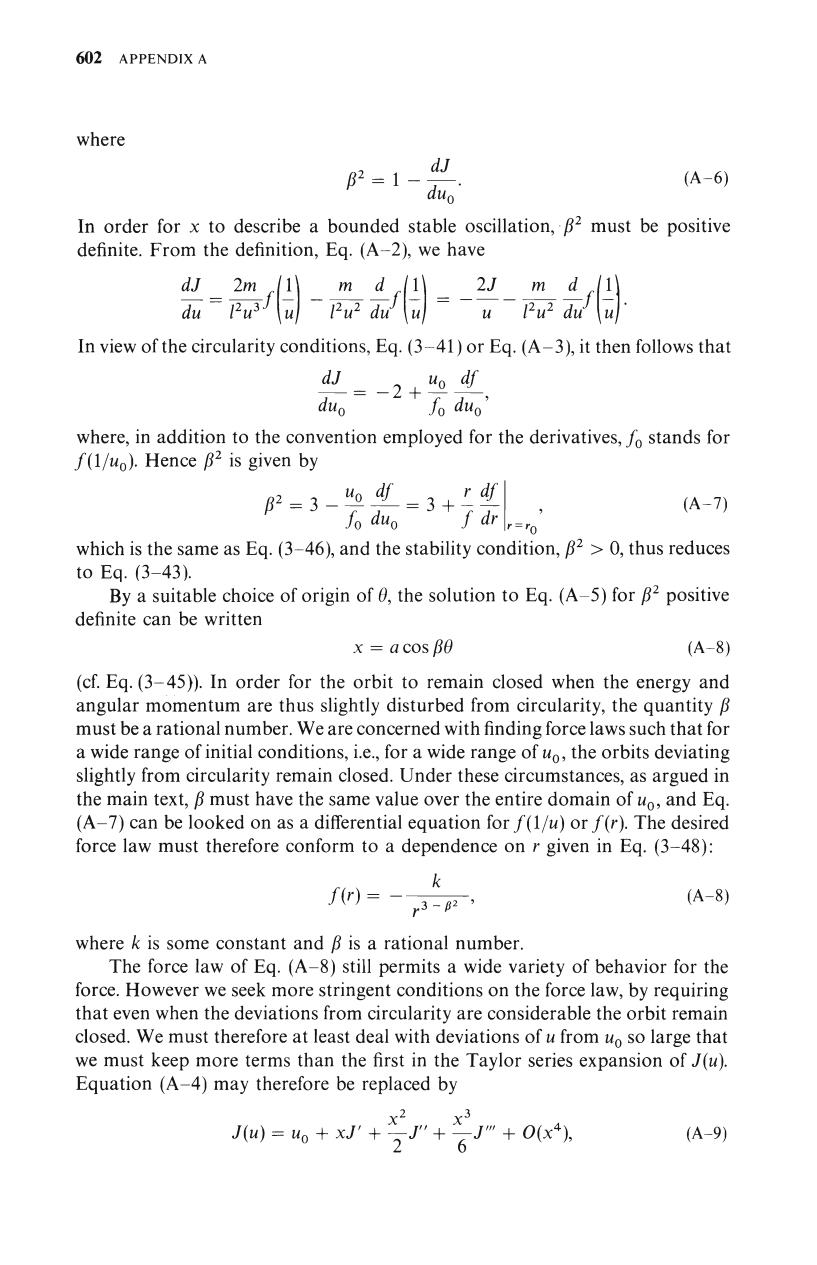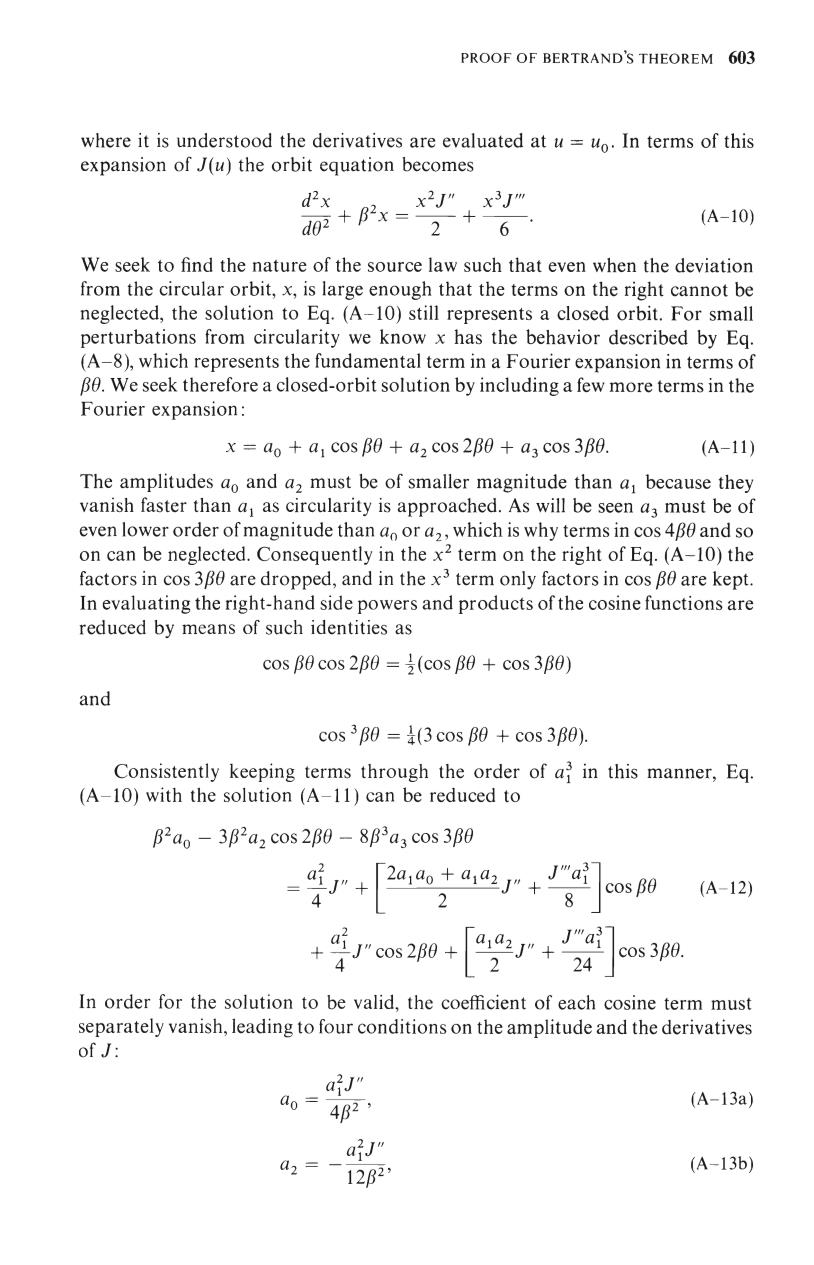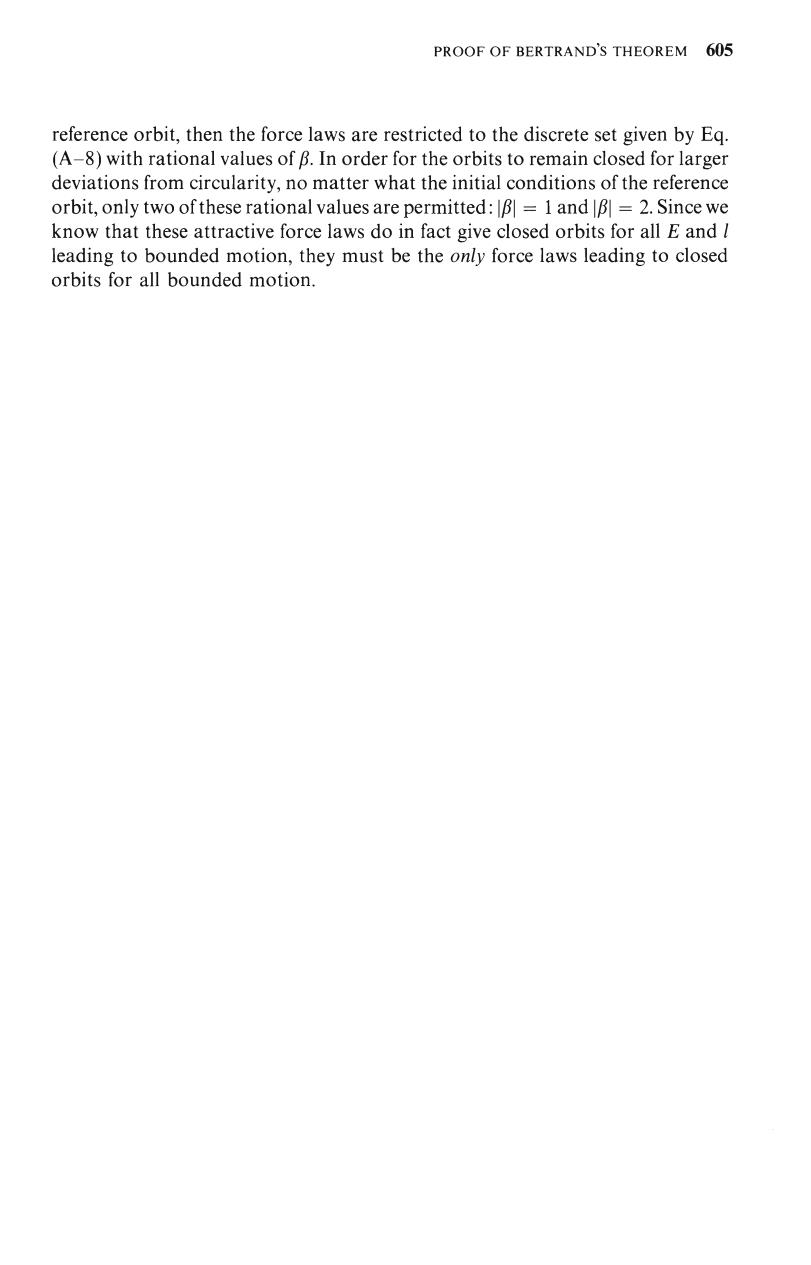
APPENDIX A Proof of Bertrand's Theorem* The orbit equation under a conservative central force,Eq.(3-34),may be written du +u=J(u), (A-1) where J0)=-平dm m d m (A-2) The condition for a circular orbit of radius ro =uo,Eq.(3-41),now takes the form uo J(uo). (A-3) In addition,of course,the energy must satisfy the condition of Eq.(3-42).If the energy is slightly above that needed for circularity,and the potential is such that the motion is stable,then u will remain bounded and vary only slightly from uo and J(u)can be expressed in terms of the first term in a Taylor series expansion about J(uo): =6+u-o品+ou-w (A-4) As is customary,the derivative appearing in Eq.(A-4)is a shorthand symbol for the derivative of J with respect to u evaluated at u=uo.If the difference u-uo is represented by x,the orbit equation for motion in the vicinity of the circularity conditions is then d2x doz+x=x J duo or d2x d0+B2x=0, (A-5) See Section 3-6. 601
APPENDIX A Proof of Bertrand's Theorem* The orbit equation under a conservative central force, Eq. (3-34), may be written where The condition for a circular orbit of radius ro = uil, Eq. (3-41), now takes the form u0 = J(uo). (A-3) In addition, of course, the energy must satisfy the condition of Eq. (3-42). If the energy is slightly above that needed for circularity, and the potential is such that the motion is stable, then u will remain bounded and vary only slightly from u, and J(u) can be expressed in terms of the first term in a Taylor series expansion about J(uo): As is customary, the derivative appearing in Eq. (A-4) is a shorthand symbol for the derivative of J with respect to u evaluated at u = u,. If the difference u - uo is represented by x, the orbit equation for motion in the vicinity of the circularity conditions is then * See Section 3-6

602 APPENDIX A where B2=1-0 (A-6) duo In order for x to describe a bounded stable oscillation,B2 must be positive definite.From the definition,Eq.(A-2),we have dJ 2 2J m du Pu u In view of the circularity conditions,Eq.(3-41)or Eq.(A-3),it then follows that d=-2+ uo df duo fo duo where,in addition to the convention employed for the derivatives,fo stands for f(1/uo).Hence B2 is given by g=3-=3+ r df ∫dr=ro (A-7) fo duo which is the same as Eq.(3-46),and the stability condition,B2>0,thus reduces toEq.(3-43). By a suitable choice of origin of 0,the solution to Eq.(A-5)for B2 positive definite can be written x=acosβ0 (A-8) (cf.Eq.(3-45)).In order for the orbit to remain closed when the energy and angular momentum are thus slightly disturbed from circularity,the quantity B must be a rational number.We are concerned with finding force laws such that for a wide range of initial conditions,i.e.,for a wide range of uo,the orbits deviating slightly from circularity remain closed.Under these circumstances,as argued in the main text,B must have the same value over the entire domain of wo,and Eq. (A-7)can be looked on as a differential equation for f(1/u)or f(r).The desired force law must therefore conform to a dependence on r given in Eq.(3-48): k f(r)=- r3-B2, (A-8) where k is some constant and B is a rational number. The force law of Eq.(A-8)still permits a wide variety of behavior for the force.However we seek more stringent conditions on the force law,by requiring that even when the deviations from circularity are considerable the orbit remain closed.We must therefore at least deal with deviations of u from uo so large that we must keep more terms than the first in the Taylor series expansion of J(u). Equation (A-4)may therefore be replaced by J(u)=uo +xJ'+ 2 2" 6J”+0x4, (A-9)
602 APPENDIX A where In order for x to describe a bounded stable oscillation, .P2 must be positive definite. From the definition, Eq. (A-2), we have In view of the circularity conditions, Eq. (3-41) or Eq. (A-3), it then follows that where, in addition to the convention empIoyed for the derivatives, fo stands for f (llu,). Hence P2 is given by which is the same as Eq. (3-46), and the stability condition, P2 > 0, thus reduces to Eq. (3-43). By a suitable choice of origin of 6, the solution to Eq. (A-5) for P2 positive definite can be written (cf. Eq. (3-45)). In order for the orbit to remain closed when the energy and angular momentum are thus slightly disturbed from circularity, the quantity P must be a rational number. We are concerned with finding force laws such that for a wide range of initial conditions, i.e., for a wide range of uo, the orbits deviating slightly from circularity remain closed. Under these circumstances, as argued in the main text, fl must have the same value over the entire domain of u,, and Eq. (A-7) can be looked on as a differential equation for f (llu) or f (r). The desired force law must therefore conform to a dependence on r given in Eq. (3-48): where k is some constant and fi is a rational number. The force law of Eq. (A-8) still permits a wide variety of behavior for the force. However we seek more stringent conditions on the force law, by requiring that even when the deviations from circularity are considerable the orbit remain closed. We must therefore at least deal with deviations of u from uo so large that we must keep more terms than the first in the Taylor series expansion of J(u). Equation (A-4) may therefore be replaced by

PROOF OF BERTRAND'S THEOREM 603 where it is understood the derivatives are evaluated at u =uo.In terms of this expansion of J(u)the orbit equation becomes 0+Bx=Jxm d2x 2+6 (A-10) We seek to find the nature of the source law such that even when the deviation from the circular orbit,x,is large enough that the terms on the right cannot be neglected,the solution to Eq.(A-10)still represents a closed orbit.For small perturbations from circularity we know x has the behavior described by Eq. (A-8),which represents the fundamental term in a Fourier expansion in terms of B0.We seek therefore a closed-orbit solution by including a few more terms in the Fourier expansion: x=a0+a1cosβ0+a2cos2β0+a3cos3β0. (A-11) The amplitudes ao and az must be of smaller magnitude than a because they vanish faster than a,as circularity is approached.As will be seen a3 must be of even lower order of magnitude than ao or a2,which is why terms in cos 480 and so on can be neglected.Consequently in the x2term on the right of Eq.(A-10)the factors in cos 380 are dropped,and in the x3 term only factors in cos B0 are kept. In evaluating the right-hand side powers and products of the cosine functions are reduced by means of such identities as cos B0 cos 2B0 =(cos B0 cos 3B0) and cos3B0 =(3 cos B0 cos 3B0). Consistently keeping terms through the order of a in this manner,Eq. (A-10)with the solution (A-11)can be reduced to B2ao-3B2a2 cos 280-8B3a3 cos 380 +[2a,oa2J”+ J"a cos B0 (A-12) 41 8 cos3β0. 2 24 In order for the solution to be valid,the coefficient of each cosine term must separately vanish,leading to four conditions on the amplitude and the derivatives of J: aiy a0= 4B2, (A-13a) aJ" a2=- 12B2 (A-13b)
PROOF OF BERTRAND'S THEOREM 603 where it is understood the derivatives are evaluated at u = u,. In terms of this expansion of J(u) the orbit equation becomes We seek to find the nature of the source law such that even when the deviation from the circular orbit, x, is large enough that the terms on the right cannot be neglected, the solution to Eq. (A-10) still represents a closed orbit. For small perturbations from circularity we know x has the behavior described by Eq. (A-8), which represents the fundamental term in a Fourier expansion in terms of PO. We seek therefore a closed-orbit solution by including a few more terms in the Fourier expansion : x = a, + a, cos PO + a, cos 2PO + a, cos 3P8. (A-1 1) The amplitudes a, and a, must be of smaller magnitude than a, because they vanish faster than a, as circularity is approached. As will be seen a, must be of even lower order of magnitude than a, or a,, which is why terms in cos 4PO and so on can be neglected. Consequently in the x2 term on the right of Eq. (A-10) the factors in cos 3p6' are dropped, and in the x3 term only factors in cos PO are kept. In evaluating the right-hand side powers and products of the cosine functions are reduced by means of such identities as and cos 3p0 = i(3 cos PO + cos 380). Consistently keeping terms through the order of a: in this manner, Eq. (A-10) with the solution (A-11) can be reduced to P2ao - 3p2a2 cos 2/38 - 8P3a3 cos 3pe =-J"+ a: 4 cos (A-12) a: + -J"cos~PO + 24 I cos 3pO. 4 In order for the solution to be valid, the coefficient of each cosine term must separately vanish, leading to four conditions on the amplitude and the derivatives of J: (A- 13a) (A- 13b)

604 APPENDIX A 2a1a0+a1a2J"+ J"a 0= 81 (A-13c) 2 a3=- 1「aa2J”+ J"a 24 (A-13d) It should be remembered that we already have shown,on the basis of slight deviations from circularity,that for closed orbits the force law must have the form of Eq.(A-8)or that J(u)is given by mk J=+P-职 (A-14) Keeping in mind the circularity condition,Eq.(A-3),the various derivatives at uo can be evaluated as J”= B2(1-B2) uo (A-15a) and J”=-B21-B21+B2) (A-15b) uo Equations(A-13a,b)thus say that ao/a and az/a are of the order of a/uo, which is by supposition a small number.Further,Eq.(A-13d)shows that a3/a,is of the order of(a/uo)2,whichjustifies theearlier statement that a is oflower order of magnitude than ao or a2. Equation (A-13c)is a condition on B only,the condition that in fact is the principal conclusion of Bertrand's theorem.Substituting Eqs.(A-13a,b)and (A-15)into Eq.(A-13c)yields the condition B2(1-B2)(4-B2)=0. (A-16) For deviations from a circular orbit,that is,B0,the only solutions are =10=合 (A-17a and B2=4,f)=-kr. (A-17b) Thus the only two possible force laws consistent with the solution are either the gravitational inverse-square law or Hooke's law! We started out with orbits that were circular.These are possible for all attractive force laws over a wide range of l and E,whose values in turn fix the orbital radius.The requirement that the circular orbit be stable for all radii already restricts the form of the force law through the inequality condition of B2>0(Eq.(3-48)).If we further seek force laws such that orbits that deviate only slightly from a circular orbit are still closed,no matter what the radius of the
604 APPENDIX A (A- 13d) It should be remembered that we already have shown, on the basis of slight deviations from circularity, that for closed orbits the force law must have the form of Eq. (A-8) or that J(u) is given by (A- 14) Keeping in mind the circularity condition, Eq. (A-3), the various derivatives at uo can be evaluated as and J"' = -P2(1 - P2)(1 + P2) u; (A- 15a) Equations (A-13a, b) thus say that ao/a, and a2/a, are of the order of al/uo, which is by supposition a small number. Further, Eq. (A- 13d) shows that a3/al is of the order of (a,/~,)~, which justifies the earlier statement that a, is oflower order of magnitude than a, or a,. Equation (A-13c) is a condition on P only, the condition that in fact is the principal conclusion of Bertrand's theorem. Substituting Eqs. (A-13a, b) and (A-15) into Eq. (A-13c) yields the condition P2(1 - P2)(4 - P2) = 0. (A- 16) For deviations from a circular orbit, that is, p # 0, the only solutions are (A- 1 7a) and P2 = 4, f (r) = - kr. (A-17b) Thus the only two possible force laws consistent with the solution are either the gravitational inverse-square law or Hooke's law ! We started out with orbits that were circular. These are possible for all attractive force laws over a wide range of 1 and E, whose values in turn fix the orbital radius. The requirement that the circular orbit be stable for all radii already restricts the form of the force law through the inequality condition of P2 > 0 (Eq. (3-48)). If we further seek force laws such that orbits that deviate only slightly from a circular orbit are still closed, no matter what the radius of the

PROOF OF BERTRAND'S THEOREM 605 reference orbit,then the force laws are restricted to the discrete set given by Eq. (A-8)with rational values of B.In order for the orbits to remain closed for larger deviations from circularity,no matter what the initial conditions of the reference orbit,only two of these rational values are permitted:B=1 and B=2.Since we know that these attractive force laws do in fact give closed orbits for all E and I leading to bounded motion,they must be the only force laws leading to closed orbits for all bounded motion
PROOF OF BERTRAND'S THEOREM 605 reference orbit, then the force laws are restricted to the discrete set given by Eq. (A-8) with rational values of P. In order for the orbits to remain closed for larger deviations from circularity, no matter what the initial conditions of the reference orbit, only two of these rational values are permitted: = 1 and IPI = 2. Since we know that these attractive force laws do in fact give closed orbits for all E and 1 leading to bounded motion, they must be the only force laws leading to closed orbits for all bounded motion